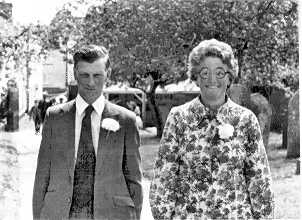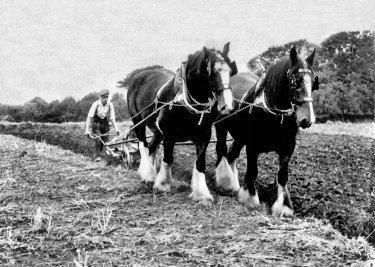

|
Mr A. Beer (AB) was born in 1915 at Prospect in Thelbridge Parish. His parents came from Luckett Mill in Knowstone Parish. His father worked at Woodford for Mr S. Haye's father. (A.B) attended school at Stockleigh Pomeroy. Nora was born in 1925 in Stockleigh Pomeroy and lived there until 1942. In the field west of the triangular field in the angle of Westway Cross, there used to be a well which was used for taking on water by steam engines and steam lorries due, perhaps, to the chronic shortage in the Witheridge water supply. Across the road from the well used to be some burnt out houses and the field there is known as "burnt out houses." One of the engines which used the well was Nott's steam engine, used to drive his thresher and driven by Freddie Mayne, whose engine was named "Spitfire." Freddie Mayne, as was the custom, used to stop the night where he was threshing. he used to "get a bit cidery" and start singing although, he couldn't sing at all. His favourite was "a beautiful golden picture in a beautiful golden frame." Once, he was threshing at Middlewick and George Mayne's jacket went down into the thresher and the thresher went "woomf" and "Toz's" (Mr Gibson, Middlewick) grandfather, Hughie, said "Was you wearing it George?" (A.B) has seen "Spitfire" stand on its hind legs as it was light in front. Once where West Middlewick now is, "Spitfire" was roping the thresher out into the road in the mud and got stuck, blocking the main road traffic. (A.B) recalls a woman driver saying "I can't wait" and Freddie Mayne said he'd keep her twenty minutes and then she could go for the police." (AB) started work in 1929 at Westway, living in. He started competitive ploughing at the age of 17 and never missed a ploughing match until he left Westway in 1966. He didn't start at 14 on horses, ploughing, as no 14 year old could manage a pair of plough horses. At 6.30 a.m. the horses had to be fed, watered, cleaned out, and then groomed before breakfast. By 8 o'clock they'd be tackled up and ready to go. At about 12.30, the horses were taken out of the plough, and brought in to feed and (AB) had dinner before going out again at 2 p.m. If, at the end of the day, the horses legs were muddy, then they had to be taken down to the river at Westway Mill to wash their legs off.
Westway had one of the last working round houses in the district. Each horse was tied by a chain and, as there could be up to five horses working at a time, one behind the other, "a young one had no chance but to go." They drove the barn like machinery. You could look out the barn door and say "get on." Walking around in this way they wore a trough in the floor that had to be filled in from time to time. One horse was needed for crushing apples, two for winnowing, three for grinding and four or five for threshing; which only separated the corn from the chaff and from the straw, and the winnower had to be used next. At Westway, there was always work for four horses. They used to breed horses, both heavy horses and hunters. Stallions used to come round, for Witheridge they used to stand at the Hare and Hounds. Shire stallions were usually quiet and ridden by a groom. (AB) remembers 'Menmeden Safety' as being a famous Shire stallion ridden by a tiny groom. Most stallions came from "Webbers to Hilltop" (near Cadeleigh.) "Rangatira" was "the most famous stallion that travelled." He was smaller than a shire, and was "a devil." As Shires were a bit heavy, some farmers preferred "a less clumsy horse for working." There were always three and sometimes four horses in the binder. At Westway, the fourth horse was added in "to pull the binder up the hill" and then taken out again each time. If the hill was very steep then the binder came up out of work, as otherwise "the corn would pile up over." (AB)'s father recalled that the 'Revel at Knowstone' was held at harvest time, and could remember cutting corn with a mower and by hand. On one occasion they were told to cut a field before going to the revel and there were so many cutting by hand in this field that they went down once only and finished. "One chap was corn-tier champion and could tie a sheaf, pitch it up in the air and tie another before the first came down." The first tractor that (AB) remembers was owned by Mr Matthews at Mill Barton, and he recalls that Bert Matthews was said to have fallen out with his father, and had taken part of this tractor away with him. Old Mr Shapland at Lewdon probably had the first tractor round here in the early Twenties. (AB) remembers "the tragedy at Witheridge Mill" when Bert Adam's first wife drowned herself and her two children in the Mill Leat. Charlie Maire and George Partridge brought them up. Bert Adams opened up a blacksmith's shop in opposition to Baker's. He lived at Anstey's Court and blacksmith's shop was on the three cornered piece at Chapner's Cross. Anstey's Court was "one main court and one little court off to the right." The occupants of Anstey's Court had the first chance of the first council houses built in Witheridge after the 1939-45 war. Miss Meacham's father was a roadman, a lengthsman, and his length was from Nomansland to Newbridge. "He'd be talking a quarter mile before you got to him and he was still talking a quarter mile after you'd gone." The roads after the 1914-18 war were bad due to the timber haulage during the war. Previous Last Edited 03/07/2006 Copyright © 2000-2006 Witheridge Unless otherwise indicated on the page in question, the photographic images reproduced on this site belong to the Witheridge Archives, and, as such may not be reproduced for commercial purposes without written permission. However, you are welcome to use any of the photographs belonging to the archive for personal and/or non-commercial use. Any material shown as not being owned by the archive may not be reproduced in any form without first receiving written permission from the owner of the material in question. |



